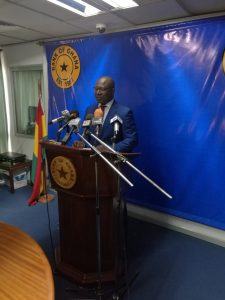
The Monetary Policy Committee (MPC) of the Bank of Ghana (BoG) has maintained its policy rate at 25.5 percent today, citing the declining trends observed in headline inflation, core inflation and postive inflation expectations.
The policy rate is the rate at which the Central Bank does its overnight lending to the universal banks in the country.
It also influences commercial bank lending rates in the country which are hovering around 29 to 35 percent according to the bank.
With the keeping of the rate, all the about 31 banks are expected to keep their base rates unchanged.
Addressing journalists in Accra, the Governor of the BoG, Dr Abdul-Nashiru Issahaku explained that; “the committee viewed the risks to inflation and growth as balanced and decided to maintain the Monetary Policy Rate at 25.5 percent”.
Nonetheless, there are concerns regarding the inflation outlook, which could be impacted by the pass-through effects of the recent exchange rate volatility, persistent increases in food inflation and the fiscal outturn, he said.
“There is therefore the need to return to the path of fiscal consolidation to complement the tight monetary policy stance to deliver on the medium term inflation target”.
Dr Issahaku who is also the Chairman of the MPC observed that headline inflation continues to ease, closing the year at 15.4 percent from 15.8 percent inOctober 2016. This was supported by tight monetary policy and relative stability of the exchange rate, he explained.
Similarly, underlying inflation pressures, measured by core inflation (CPI excluding energy and utility prices) declined significantly.
From 15.2 percent in October, core inflation fell to 14.7 percent in November, and further to 14.6 percent in December 2016. Also, inflation expectations by consumers and the financial sector eased in line with trends in headline inflation.
These developments in headline inflation during the year, according to Dr Issahaku were broadly in line with the Bank’s 2016 forecasts.
At this MPC round, however, the underlying assumptions in the forecasting framework were revised to reflect the recent upward adjustments in ex-pump prices, exchange rate depreciation and a higher than budgeted fiscal deficit outturn for 2016.
Consequently, the baseline forecast horizon for the medium-term inflation target has shifted into 2018.This inflation outlook could however improve if the fiscal consolidation process is restored, alongside monetary policy tightness and exchange rate stability.
“Economic activity remained modest throughout the year, against the backdrop of policy tightness, oil and gas production challenges at the Jubilee field, and lingering consequences of the power supply constraints.
The updated Composite Index of Economic Activity (CIEA) to November 2016 points to some moderation in the pace of economic activity reflecting declines in industrial consumption of electricity, cement sales, tourist arrivals and domestic VAT collection.
Dr Issahaku hinted that although growth conditions remain modest, prospects are positive, underpinned by improved oil and gas production from the new oil fields, the gradual rebound in growth in private sector credit and improved sentiments and expectations.
“In the outlook, the risks to growth include policy uncertainties especially in the global environment”, he told journalists at MPC press conference in Accra today.
By Masahudu Ankiilu Kunateh, African Eye Report
Email: mk68008@gmail.com




